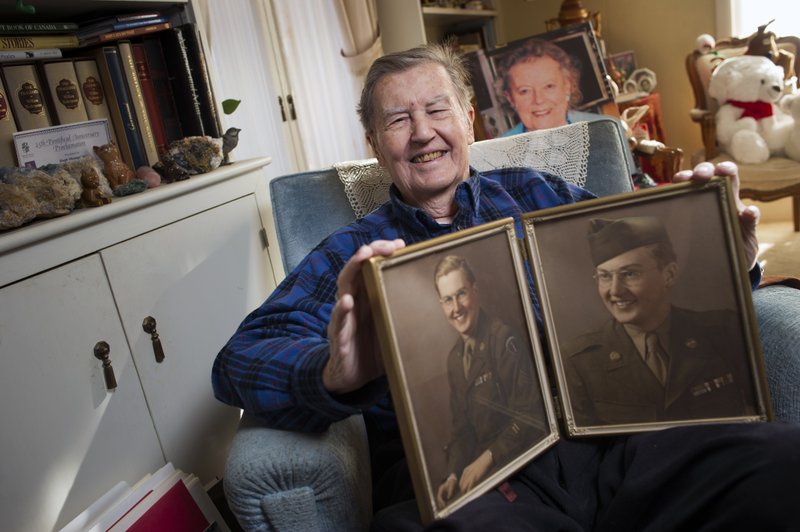WASHINGTON -- Hugh Montgomery never wrote a memoir. That just wasn't done among his generation of spies.
But his exploits as a World War II combat veteran, CIA cold warrior and Washington power player could have filled a dozen books and made him a revered figure among the insiders who know his story.
Montgomery jumped into Normandy on D-Day with the 82nd Airborne. He went behind enemy lines for the Office of Strategic Services, the CIA's forerunner, where he was among the first Americans to enter the Buchenwald concentration camp. After returning to Harvard to earn his Ph.D. and teach, he joined the newly formed CIA, where he led spying operations against the Soviets in Rome; Paris; Vienna; Athens, Greece; and Moscow.
"I'd call him one of the founding fathers of the CIA," said Leon Panetta, a former director of the spy agency who consulted Montgomery occasionally.
Panetta spoke in a video tribute played earlier this month at a black-tie dinner of the OSS Society, which is raising money to build a museum.
After his overseas career, Montgomery ran the State Department's intelligence bureau for a time, earned the rank of ambassador and settled into a role as the CIA's elder statesman. He regaled lunch partners in the seventh-floor dining room while he worked on an 11-volume classified history of the CIA's relationships with other spy services.
He retired from the CIA in May 2014 at the age of 90, after the history was finished. He turns 92 on Sunday.
CIA Director John Brennan, who last year awarded Montgomery the Distinguished Career Intelligence Medal, called him "one of the greatest American heroes of our time."
These days, a broken foot has made it hard for Montgomery to get up and down the stairs in his suburban home near the CIA's Langley, Va., headquarters. The February death of his wife of 66 years, Annemarie, has left a void.
But his wit remains sharp and his stories flow easily.
After a semester at Harvard, he enlisted in 1941 before Pearl Harbor and volunteered for the airborne. He speaks about the D-Day jump into France as if it were yesterday.
"It's awful black out there when you look down unless you see a few tracer bullets coming your way," he said.
Fluent in eight languages, including German, he was recruited into a special counterintelligence detachment of the Office of Strategic Services, an elite wartime spying organization.
Often, his job was to sneak behind enemy lines in Germany to abduct a Nazi who could provide valuable intelligence. He and his men typically had the exact addresses of their targets, which he believes came through British penetration of German code.
In April 1945, he was on a mission in a vehicle with five other operatives in search of a nuclear physicist in eastern Germany, when they came upon a clearing and "a ghastly smell."
He would later learn it was Buchenwald, where 56,000 prisoners died. The survivors had just seized control, and Montgomery said his group passed guards who had their hands up, trying to surrender to any Americans they saw.
"There were a very few of the prisoners who were still vertical," he said.
He gave the survivors all of his cigarettes and radioed the U.S. Army, breaking his secrecy protocol. Some survivors gave him a German SS flag that flew over the camp, which is now rolled up in his basement.
Montgomery told the former inmates he had to go. They had a request: that he leave the guards to them.
"I said, 'They're yours,'" Montgomery recalled.
The camp gave him nightmares, Montgomery said, but his World War II duty also led him to meet Annemarie in a remote Austrian mountain town. They had two children, one of whom now works for the National Security Agency.
After the war, Montgomery was recruited by CIA officer Richard Helms to join the CIA. He was sent to Berlin, where he worked on a secret tunnel designed to tap Soviet communications.
In the early 1960s, Montgomery, then deputy station chief in Moscow, was to retrieve an information packet hidden by the agency's top Soviet informant during a dinner party at the U.S. ambassador's residence in Moscow.
He had to stand on the sink to reach into a high-up toilet tank to retrieve the dead drop. The plumbing began to pull away from the wall. Montgomery's suit was soaked up to his sleeve as he reached in and grabbed the packet.
With Annemarie clutching his wet arm, Montgomery slipped away from the party with no one the wiser. CIA asset Col. Oleg Vladimirovich Penkovsky, code-named Hero, went on to provide information that helped President John F. Kennedy defuse the Cuban Missile Crisis, the agency says.
Montgomery served in the CIA through its darkest chapters -- the coups, the assassinations and the interrogations of detainees after the Sept. 11, 2001, attacks, now widely considered torture. He doesn't claim the CIA's record is without blemish.
But he said he believes the spy agency has been a force for good.
"Nobody knows a lot of the good things that it did," he said. "Did it make mistakes? Unquestionably. This is not an exact science, espionage."
A Section on 11/26/2015
